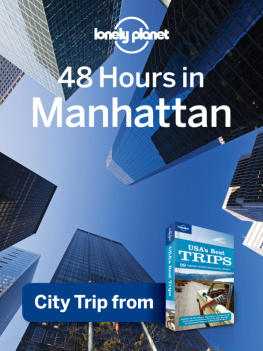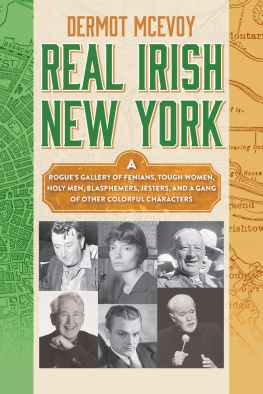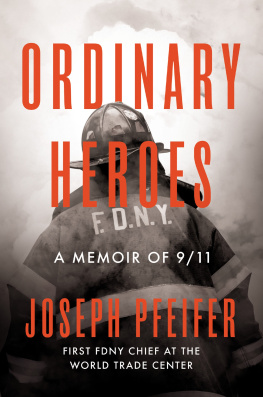Firefight
The Century-Long Battle to Integrate New Yorks Bravest
Ginger Adams Otis

The author and publisher have provided this e-book to you for your personal use only. You may not make this e-book publicly available in any way. Copyright infringement is against the law. If you believe the copy of this e-book you are reading infringes on the authors copyright, please notify the publisher at: us.macmillanusa.com/piracy.
Contents
Prologue
East Harlem
February 2012
FDNY Captain Paul Washington jerked his minivan to a halt on East 123rd Street near Second Avenue to find a line of impatient students waiting for him. There was just enough light in the settling dusk for him to see annoyed expressions on the 30 or so faces that stared his way as he jumped out. It was 7:45 p.m., and he was late to set up for his own class. He should have been in East Harlem about 30 minutes ago, but traffic from his Brooklyn firehouse delayed him. Washington pushed his rimless glasses a little higher on his nose and turned to the black firefighter who drove in with him from Engine 234.
Can you find a place to park? Im going to grab this stuff and head downstairs, Washington said, hefting a couple of boxes full of tutorial workbooks. Inside the Taino Towers, a huge housing complex in the center of Spanish Harlem, colloquially called El Barrio, six more firefighters waited for him. Like him, they were all members of the Vulcan Society, the official fraternal organization for blacks who made it into the FDNY. He hurried everyone a flight below into the basement room the Vulcans had rented for the night. Something about the line of students outside nagged at him. In the few seconds hed been able to look them over, Washington caught a glimpse of a cluster of whites in the back. That alone wasnt unusual. A few always showed up at the Vulcan classes, even though everyone knew the tutorials were primarily meant for black kids studying to become firefighters. But tonight that brief glance wedged itself into his head, probably because of the e-mail he received earlier warning him that some whites were planning to crash his classes. It had come from a fellow FDNY officer, one of the heads of the Uniformed Fire Officers Association, the union that represented the rank of lieutenant and above. The officer wasnt a supporter of the Vulcans cause, but he felt honor-bound to let Washington know something was brewing.
I dont like to see anyone blindsided, the officer wrote.
Washington wondered what the night might bring. He motioned to the Vulcans with him to set up the check-in point while he got busy unfolding chairs. By the look of it, theyd need at least 200. If some white guys wanted to attend his class, let them come, he decided. His tall, narrow frame moved in a relaxed rhythm as he worked. A buzz of anticipation fueled him. In his nearly 25 years in the FDNY, hed tutored hundreds, if not thousands, of black and brown kids who wanted to become firefightersall on his own time. Hed lectured, heckled, encouraged and drilled them on the best way to gain entry to the fire department and start a career that everyonein the FDNY at leastagreed was the best job in the world. The key to joining the select fraternityand it was a fraternity, even with a handful of women in the rankswas to score well on the FDNYs written entrance exam. Given only once every four years on average, that written test was the first hurdle to overcome to get a coveted firefighting job.
Its not enough to just pass, Washington would drill into his students heads. You have to score in the top 10 percent to have a real chance.
The competition was fierceand Washington fully understood why. Aside from the honor and prestige that came with being a member of the citys beloved FDNY, the average firefighter stood to earn more than $100,000 within five years of joining the agency. And that was just the first step on the pay ladder. By the time firefighters climbed a few rungs up the promotional chain, they could pull down at least $140,000not including overtime, and there was plenty of that. Then there was the unlimited paid sick leave, the five weeks of paid vacation, the very generous retirement pension andthe ultimate public employee benefitthe tax-free, three-quarters pay, disability pension awarded to Bravest who got hurt on the job. And, to top it all, firefighters only worked two 24-hour shifts every eight days. It was a career filled with daunting, exhausting challenges, often enduring killer heat and haze, sometimes rescuing people in car crashes, helping heart attack victims, people trapped in elevators, or responding to stabbings or shootings. Fires could mean exploring filthy basements or hallways on hands and knees in pitch black smoke, slogging up seemingly endless flights of stairs in the increasingly vertical city, with as much as 70 pounds of gear on your backand always with the possibility that the job could take a firefighters life. But nobody could deny the city rewarded its firefighters handsomely.
Given all that, there were usually at least 20,000 applicants every time the FDNY cycled into a hiring phasevying for 2,500 spots at most. It was easier to get a gig with Google than the FDNY. Washington and the Vulcans did everything they could to prepare their students, and still, time and time again, the FDNY exam results rolled in with just a smattering of blacks in real contention. For the entirety of Washingtons career, thered only been about 300 blacks on a force of about 11,000. That was roughly 3 percent. It was pitiful for a city of 8.2 million, where blacks made up approximately 26 percent of the population.
And for the entire 150-year history of the FDNY, there had never been more than about 650 blacks on the job at onceabout 7 percent. That brief pinnacle came in the late 1970s, thanks to a court order that forced the FDNY to hire one black or Latino firefighter for every three whites. That order lasted for four years. The minute it expired, the city went back to pulling applicants in ranked order from its list of candidates. The number of black firefighters once again drifted downward.
But this class was about changing that. These students, blacks and Latinos, were intended to be part of the first class to enter the FDNY since the Vulcan Society filed a discrimination lawsuit against the department in 2007. And by the end of 2013, another 300 or so minority candidates would get to take the FDNY exam. Some of them would be well past the usual cutoff age of 29a few might even be over 40. Washington called them his second-chance candidates, blacks and Latinos whod taken the FDNY tests in 1999 and 2002 and didnt get hired. Some started the process but were knocked out by background checks or other FDNY criteria. Some scored above the cutoff mark of 70 but were too far out of the upper percentile to ever have a chance. Soon theyd all have a shot at trying again, thanks to the controversial ruling by a Brooklyn judge in favor of the Vulcan Societys lawsuit.
The Vulcans had forced a reluctant city and the FDNY to overhaul hiring procedures, some of which were over a century old. It had been a bitter, brutal, decade-long battle, but Washington and the Vulcans had prevailedin the courthouse, at least, Washington reminded himself. He hadnt won many hearts and minds in the firehouses to his cause. He knew he was persona non grata among the majority of white firefighters and among many of the high-ranking chiefs at FDNY headquarters too.
Washington signaled to a black firefighter to open the door. The room filled up, mostly with young men, but Washington also counted about eight women. He took that as a good sign. Maybe word about his lawsuit and the FDNY hiring changes was starting to spread, he thought. Many of his students came to class straight from a day job. He saw FedEx and UPS uniforms, greasy mechanic jackets, dust-covered work boots and tool belts carried straight from construction sites, even a Starbucks shirt as people straggled in. Without a doubt, some would be asleep before the two-hour class ended.
Next page






